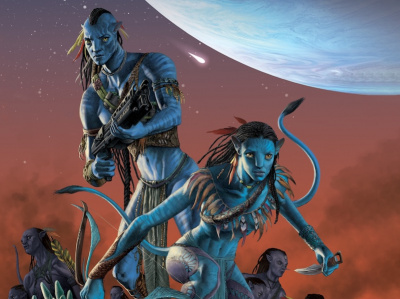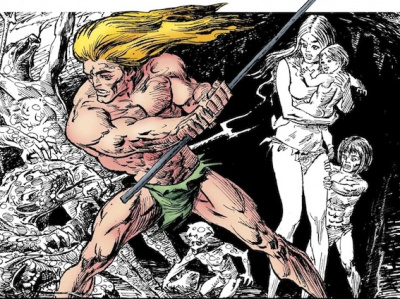Since its inception ADV's Anime Network has been fighting an uphill battle to secure a spot in the very crowded cable and satellite spectrum. To gauge the progress that the Network has made ICv2 talked with Stacy Slanina, the Anime Network's Director of Operations and company spokesman Chris Oarr to see how far they have come in realizing their goal to see 'More anime in more places.'
How long has the Anime Network been in existence?
Stacy Slanina: We started our VOD platform in December of 2002.
How would you gauge your progress, are you pretty much on track for what you hoped to do?
Stacy: Yes, I think we are on track. We are growing every day.
What percentage of the cable systems in the country do you cover?
Stacy: Well there are 110 million homes in America that are TV enabled and we are in over 25% of those, and there are approximately 29 million digital cable homes and in some form we are available in over 90 per cent of those digitally enabled cable homes. We think that almost all cable systems will go digital within several years. Right now we have over half a million unique visitors per month on the VOD side alone. We are also in two major cable systems (Rogers & Shaw) in Canada.
Can you explain some of the terms used to describe cable networks such as 'linear' and 'Video on Demand'?
Chris Oarr: 'Linear' describes just a standard cable station like CNN, the content is out there and you tune in, when you tune in. When we talk about interactive TV that includes all the different forms in which you can tune in to watch what you want, when you want. 'Interactive' is kind of interchangeable with 'On Demand' and there are two ways in which the Anime Network delivers 'On Demand' programming. The first is 'Video On Demand -- VOD, which means that you can watch the episode or the movie you want when you want, and we offer a mix of free and 'transactional' VOD all the time. In essence we are offering you the opportunity in the VOD networks to rent the shows you want to see and they are available anytime you are ready to watch it. Subscription VOD or SVOD gives you the same options -- to watch when you want to watch -- it just means that you are paying a flat monthly fee for unlimited access to a constantly changing basket of programs.
Stacy: It's over 25 hours of programming and the content refreshes weekly -- once a week on Thursday about 25% of the content refreshes -- it's new. So you have a month to watch something on SVOD, but there's new stuff every single week.
Chris: Whether you have access to VOD or to SVOD depends on your cable provider. A growing number of networks are picking up SVOD, which is clearly a superior way to watch it.
Stacy: SVOD service is a better value for the viewer. We started in one system and it was very successful and now we are in six or seven systems with subscriptions, and we are talking to other systems about offering the subscription service.
What is the standard fee for the SVOD service?
Stacy: The subscription service runs at $6.95 a month standard, though it's even less on some systems. With pay-per-views at typically $3.99 -- for a few dollars more you get a whole month's worth of viewing and a wide variety of programming to watch. And you can pick the place and time to watch the shows -- every day there's going to be 25 hours of content that you can watch at anytime. You are not locked into a broadcast schedule. You can watch the shows when you want. It's like your own personal anime Tivo and new content is available every week.
What are the chances of getting on Direct TV or the Dish Network Satellite Services?
Stacy: Right now the Dish Network is experimenting with a box that will allow VOD in a portion of their homes -- and we have some content on there now, we have Samurai X: The Motion Picture and The Tree of Palme. We are also experimenting with the Dish Network on an HD platform on a pay-per-view basis and we have a couple of titles on there, Lady Death and Rahxephon: The Motion Picture. We have been negotiating with Direct TV for a launch in February, with a transactional or pay-per-view model -- you will pay a flat fee, but you will get a DVD-type rental, four episodes for example plus maybe some extras, and you can rent that for an extended period of time.
Chris: Stacy and her group are really pioneers. They have been developing these concepts like SVOD as they go along, and other networks and networks-in-development are watching the Anime Network and what they do very closely.
Are you providing basically the entire ADV catalog?
Stacy: Well we are providing 25 hours at any one time, but it's not all from ADV. We hope to bring the best anime available to television and we expect to offer more titles from more companies as we go along. We already have offered several titles from The Right Stuf and from Geneon.
When ADV comes out with a new series like The Fuccons will there be a lag before that is available to the Anime Network?
Stacy: Well The Fuccons is currently running right now on the Network and it hasn't even been released yet on DVD. So we premier titles and we run them simultaneously with some of the DVD releases, just depending on the rotation and the scheduling at the time.
With any kind of a start-up operation like the Anime Network it takes time to turn a profit, has the Network turned a profit yet?
Chris: Stacy and her group have been working extremely hard to do what much larger groups that spend a lot more money are trying to do, and she's a little bit modest on this point, but the fact that we are in the black with the Anime Network, this close into the game and this far out on the frontier, is one of the proudest achievements of any of the ADV companies, and it's a remarkable testament to the power of interactive television. SVOD has enabled us to overachieve. You take HBO on Demand out of the equation and there's not a lot out there that is coming close to the size of the audience that we are able to pull.
Stacy: We were one of the first subscription services to launch and the only one that comes close to beating us is WWE on Demand as an SVOD. We owe it (out success) to the viewers, they have sought us out and made the Network a success. We are trying to educate more people on how to use VOD and SVOD and we are working on building a guide for our Website where a potential viewer could punch in a zip code and we would have a digital cable guide showing how to access the content.
You do a lot of marketing at conventions -- how important are anime conventions to you?
Stacy: Very important, we go ourselves and we get to talk to people. We are after all building a product to sell to that target demographic and I would like to know what they want. People told us they wanted subtitled programming so we started subtitled programming on our network -- we started a block called 'Sub-Sessions' -- right now I think we have Samurai X and Princess 9 running subtitled on the Network. Right now I think about 10% of our programming is subtitled.
We are figuring this out as we go along and we are grateful for feedback from our subscribers. It's not always a perfect process and there has been a learning curve, but we want to thank our fans and our viewers for bearing with us and helping us make the Anime Network a number one product.







